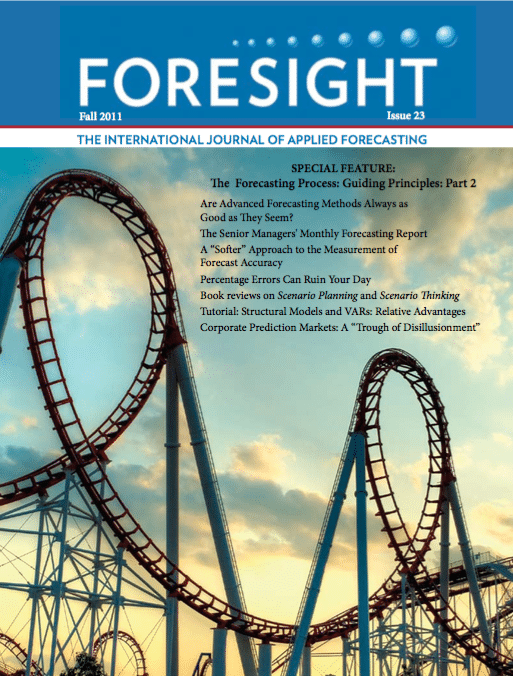FORESIGHT, Issue 23
$45.00
Description
Fall 2011
Special Feature: Corporate Prediction Markets: Pitfalls and Barriers
- Prediction Markets and the “Trough of Disillusionment” Andreas Graefe Foresight’s Spring 2011 issue included Robert Rieg and Ramona Schoder’s article “Corporate Prediction Markets: Pitfalls and Barriers” on the hurdles that must be overcome to properly establish a corporate prediction market (CPM). They enumerated four principal obstacles: (1) identifying the appropriate subject to be forecast; (2) defining the subject clearly enough for people to know what they are betting on; (3) motivating and securing an adequate number of participants; and (4) embedding the CPM within the corporate culture. Their conclusion: only selective use of a CPM would be feasible and practical. In the following response, Foresight’s Prediction Market Editor Andreas Graefe notes that certain of the challenges can readily be overcome, and that a promising role for CPMs lies ahead – if the conditions for success are better understood.
- Commentary by Robert Rieg and Ramona Schoder
Articles
- A “Softer” Approach to the Measurement of Forecast Accuracy John Boylan
Our Summer 2010 issue contained a letter to the editor from David Hawitt, suggesting that forecast managers would be more receptive to hearing about forecast accuracy rather than forecast error. If forecast error were measured by the average absolute percentage error (MAPE), then forecast accuracy would be the complement, 100% – MAPE. David argued that while reporting (e.g.) a 40% average error might generate “knee-jerk reactions and the creation of unrealistic goals,” reporting 60% accuracy stimulates executive thinking about “What can we do to improve this?”Then, in the Spring 2011 issue of Foresight, Mark Little and Jim Hoover offered their commentaries on the Hawitt recommendation. Mark had a different take on the issue: “Rather than attempt to express accuracy in a form executives think they understand, it may be better to focus on the improvements in business outcomes (the KPIs) that result through better forecasts.” The issue was carried forward in recent Linked-In exchanges, which John Boylan mentions below in his reflections. John sees the discussion in terms of the different perspectives of academics and practitioners, and attempts to reconcile these positions through the lens of Soft Systems Methodology. - Percentage Errors Can Ruin Your Day (and Rolling the Dice Shows How) Stephan Kolassa and Roland Martin Foresight has printed many articles about the calculation, interpretation, and especially the dangers of percentage error metrics, such as the MAPE. Stephan and Roland now add to the list of dangers, showing how you can be led astray if you use the MAPE to select a best forecasting method or to reward forecast accuracy. Minimizing the MAPE is often not a good idea.
- Forecasting With Structural Models and VARs: Relative Advantages and the Client Connection Dan Hamilton With this article, Foresight introduces a new section of methods tutorials. Our intention is to provide a broad overview of a method for those who are not currently specialists in that particular area, and possibly to stimulate new thinking about the proper use and goals of the methodology. Since the early 1980s, structural (“econometric”) models and vector autoregressions (VARs) have been competing forecasting techniques. The structural approach has been widely used since the 1950s by macroeconomic forecasters. The VAR approach was forcefully advocated for macroeconomic forecast use by Christopher Sims in his 1980 Econometrica article. In our first Foresight tutorial, Dan Hamilton describes the two techniques and discusses what each implies for the client connection. Certain aspects of the discussion are oriented to macroeconomic forecasting, but the main conclusions of the article apply to any forecast setting.
- The Senior Manager’s Monthly Forecasting Report Alec Finney
Every month, Fred the Forecaster, Colin the Controller, and Stan the Supply Guy get together to sort out a forecasting problem. - Hot New Research: High on Complexity, Low on Evidence: Are Advanced Forecasting Methods Always as Good as They Seem? Paul Goodwin
- Book Reviews by by Adam Gordon
Scenario Planning in Organizations by Tom Chermack
Scenario Thinking: Practical Approaches to the Future by George Wright and George Cairns







